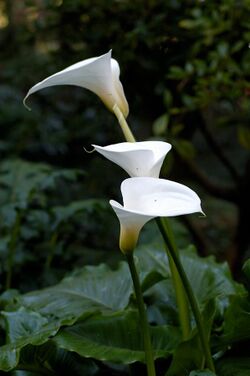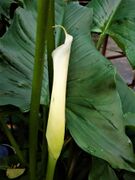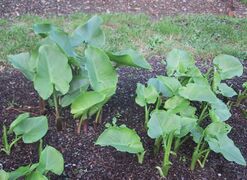Biology:Zantedeschia aethiopica
| Zantedeschia aethiopica | |
|---|---|

| |
| Scientific classification | |
| Kingdom: | Plantae |
| Clade: | Tracheophytes |
| Clade: | Angiosperms |
| Clade: | Monocots |
| Order: | Alismatales |
| Family: | Araceae |
| Genus: | Zantedeschia |
| Species: | Z. aethiopica
|
| Binomial name | |
| Zantedeschia aethiopica (L.) Spreng., 1826
| |
| Synonyms | |
Zantedeschia aethiopica, commonly known as calla lily and arum lily, is a species of flowering plant in the family Araceae, native to southern Africa in Lesotho, South Africa , and Eswatini.[2]
Description
Zantedeschia aethiopica is a rhizomatous herbaceous perennial plant, evergreen where rainfall and temperatures are adequate, deciduous where there is a dry season. Its preferred habitat is in streams and ponds or on the banks. It grows to 0.6–1 m (2.0–3.3 ft) tall, with large clumps of broad, arrow shaped dark green leaves up to 45 cm (18 in) long. The inflorescences are large and are produced in spring, summer and autumn, with a pure white spathe up to 25 cm (9.8 in) and a yellow spadix up to 90 mm (3 1⁄2 in) long.[3] The spadix produces a faint, sweet fragrance.[4]
Zantedeschia aethiopica contains calcium oxalate, and ingestion of the raw plant may cause a severe burning sensation and swelling of lips, tongue, and throat; stomach pain and diarrhea may occur.[5][6]
Distribution and habitat
Z. aethiopica is native to southern Africa, specifically Lesotho, Mozambique, South Africa , and Eswatini. It has naturalised in Kenya, Madeira, Azores, Malawi, New Zealand, Tanzania, Zambia, coastal California and Australia , particularly in Western Australia, where it has been classified as a toxic weed and pest.[7][8] The majority of invasive populations are located in coastal prairies and wetlands near human settlements.[9] It is also a highly invasive species in riparian areas and pastureland of Western Australia and New Zealand.[9] The cultivar 'Green Goddess' is listed in the New Zealand National Pest Plant Accord, which proscribes its cultivation, sale, and distribution.
The reproduction of Z. aethiopica involves seeds dispersal by birds and vegetative propagation through rhizomes that can spread when soil or garden cuttings are moved.[9]
Cultivation and uses
A number of cultivars have been selected as ornamental plants:
- 'Crowborough' is a more cold tolerant cultivar growing to 90 cm (35 in) tall, suited to cool climates, such as Ireland or Britain and the north-western United States .[citation needed]
- 'Green Goddess' has green stripes on the spathes which allow the flowers to last much longer than the original white form. 'Green Goddess' also has a more opened and wider spathe and has the tendency to develop curvy fringes at the edge of the spathe than the original white form. The first generation hybrid of 'Green Goddess' and the original white form have a light green underside on the spathe, allowing the flower to last longer than the original white form, but no green stripes on the top side.[citation needed] The New Zealand National Pest Plant Accord proscribes the cultivation, sale, and distribution of 'Green Goddess'.
- 'Pink Mist' has a pinkish base to the spathe and pink spadix. 'Pink Mist' is not a hybrid, but a colour sport. The pink colour is best developed in partial shade after rain. 'Pink Mist' is quite delicate and weak compared to the original white form and 'Green Goddess'. Unlike the latter, 'Pink Mist' has a dormant period during winter, where the leaves almost die down completely, although it is pure Zantedeschia aethiopica. The seedlings of 'Pink Mist' are also weaker than the original white form or 'Green Goddess'.[citation needed]
- 'Red Desire' has a red instead of yellow spadix and appears to be very rare.[citation needed]
- 'White Sail', growing to 90 cm tall, has a very broad spathe.[3]
The cultivars 'Crowborough'[10] and 'Green Goddess'[11] have gained the Royal Horticultural Society's Award of Garden Merit.[12]
In order to introduce colours to the large white calla lilies, like the many colours available in the dwarf summer calla lilies, attempts have been made to hybridise Z. aethiopica with Z. elliotiana. These have resulted in albino progeny, which are non-viable.[citation needed]
Zantedeschia aethiopica can be used for treatment of wastewater due to its tolerance of iron and ability to grow in wet areas.[13]
Symbolism
Until 2011, Zantedeschia aethiopica was the national flower of the island nation of Saint Helena, where it grows widely, but is considered an invasive plant.[14] Further, it is an important symbol of Irish republicanism and nationalism since 1926, because it is used to commemorate the dead of Easter 1916 and onward.[citation needed]
See also
- List of plants known as lily
Gallery
References
- ↑ Foden, W. (2010). "Zantedeschia aethiopica". IUCN Red List of Threatened Species 2010: e.T164507A5896429. doi:10.2305/IUCN.UK.2010-3.RLTS.T164507A5896429.en. https://www.iucnredlist.org/species/164507/5896429. Retrieved 18 November 2021.
- ↑ {{citation | mode = cs1 | title = Zantedeschia aethiopica | work = Germplasm Resources Information Network (GRIN) | url = | publisher = [[Organization:Agricultural Research ServAgricultural Research Service (ARS), United States Department of Agriculture (USDA) | access-date = 2017-12-18 }}
- ↑ 3.0 3.1 Huxley, A., ed. (1992). New RHS Dictionary of Gardening. Macmillan ISBN:0-333-47494-5.
- ↑ "Zantedeschia aethiopica". https://pza.sanbi.org/zantedeschia-aethiopica.
- ↑ Poisonous Plants of North Carolina Retrieved on 8-2-2009
- ↑ "Zantedeschia aethiopica". http://www.pfaf.org/database/plants.php?Zantedeschia+aethiopica.
- ↑ "Arum Lily". Weeds Australia Weed identification. http://www.weeds.org.au/cgi-bin/weedident.cgi?tpl=plant.tpl&ibra=all&card=H10.
- ↑ "Arum lily (Zantedeschia aethiopica)". Declared plant in Western Australia. http://agspsrv95.agric.wa.gov.au/dps/version02/01_plantview.asp?page=1&contentID=7&. Dept Agriculture and Food, Western Australia
- ↑ 9.0 9.1 9.2 "Zantedeschia aethiopica Profile – California Invasive Plant Council" (in en-US). https://www.cal-ipc.org/plants/profile/zantesdeschia-aethiopica-profile/.
- ↑ "Zantedeschia aethiopica 'Crowborough'". RHS. https://www.rhs.org.uk/Plants/89813/Zantedeschia-aethiopica-Crowborough/Details.
- ↑ "Zantedeschia aethiopica 'Green Goddess'". RHS. https://www.rhs.org.uk/Plants/60961/Zantedeschia-aethiopica-Green-Goddess/Details.
- ↑ "AGM Plants - Ornamental". Royal Horticultural Society. July 2017. p. 108. https://www.rhs.org.uk/plants/pdfs/agm-lists/agm-ornamentals.pdf.
- ↑ Casierra-Posada, Fánor; Blanke, Michael M.; Guerrero-Guío, Juan Carlos (June 2014). "Iron Tolerance in Calla Lilies (Zantedeschia aethiopica)" (in en). Gesunde Pflanzen 66 (2): 63–68. doi:10.1007/s10343-014-0316-y. ISSN 0367-4223. http://link.springer.com/10.1007/s10343-014-0316-y.
- ↑ "National Flower ⋅ Saint Helena Island Info ⋅ About St Helena, in the South Atlantic Ocean". http://sainthelenaisland.info/nationalflower.htm.
External links
- Alfred Pink (2004). Gardening for the Million.. Project Gutenberg Literary Archive Foundation. https://www.gutenberg.org/ebooks/11892.
- Botanicas Annuals & Perennials, Random House, Sydney, 2005, ISBN:0-09-183809-6
Wikidata ☰ Q1945905 entry
 |






